Kaplan DIPMB1 Project: Industry Knowledge and the Lending Process
VerifiedAdded on 2022/12/23
|51
|16017
|1
Project
AI Summary
This written project, designed for the DIPMB1 course on Industry Knowledge and the Lending Process, presents a detailed exploration of mortgage lending practices. The project is structured around three case studies involving different client scenarios, requiring the analysis of client needs, assessment of financial situations, and the application of responsible lending obligations. The project covers key aspects of the lending process, including gathering client information, evaluating borrowing options, conducting reasonable inquiries, understanding interest rates, and navigating loan settlements. Furthermore, it incorporates topics such as self-employed considerations, credit history impact, and dispute resolution. The project also examines financial services legislation, industry codes of practice, and the application of professional practices within the financial services industry. The assessment tasks require students to prepare loan applications, design documents, and advise on financial strategies. The project aims to provide students with practical knowledge and skills essential for working in the finance and mortgage broking industry.
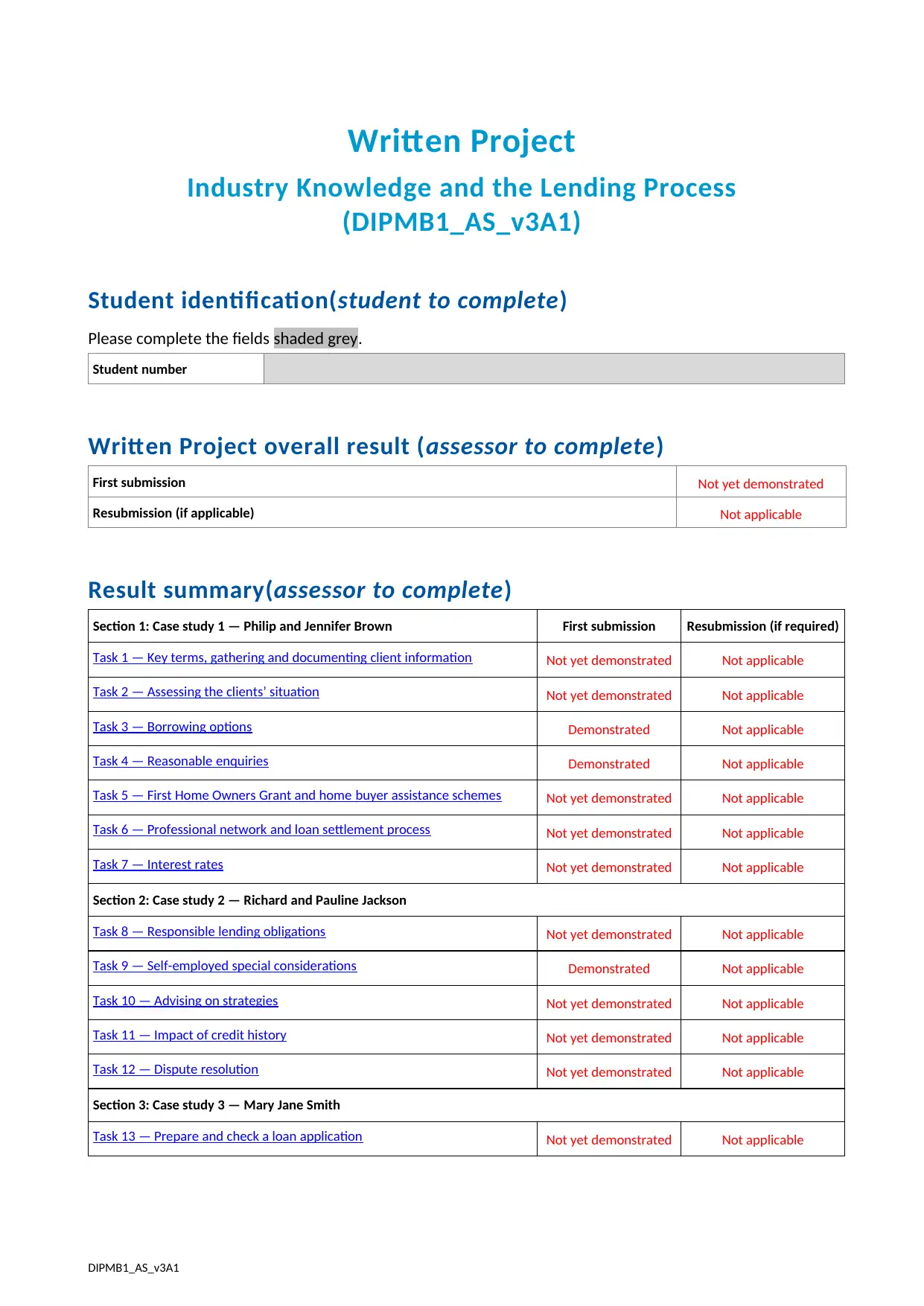
Written Project
Industry Knowledge and the Lending Process
(DIPMB1_AS_v3A1)
Student identification(student to complete)
Please complete the fields shaded grey.
Student number
Written Project overall result (assessor to complete)
First submission Not yet demonstrated
Resubmission (if applicable) Not applicable
Result summary(assessor to complete)
Section 1: Case study 1 — Philip and Jennifer Brown First submission Resubmission (if required)
Task 1 — Key terms, gathering and documenting client information Not yet demonstrated Not applicable
Task 2 — Assessing the clients’ situation Not yet demonstrated Not applicable
Task 3 — Borrowing options Demonstrated Not applicable
Task 4 — Reasonable enquiries Demonstrated Not applicable
Task 5 — First Home Owners Grant and home buyer assistance schemes Not yet demonstrated Not applicable
Task 6 — Professional network and loan settlement process Not yet demonstrated Not applicable
Task 7 — Interest rates Not yet demonstrated Not applicable
Section 2: Case study 2 — Richard and Pauline Jackson
Task 8 — Responsible lending obligations Not yet demonstrated Not applicable
Task 9 — Self-employed special considerations Demonstrated Not applicable
Task 10 — Advising on strategies Not yet demonstrated Not applicable
Task 11 — Impact of credit history Not yet demonstrated Not applicable
Task 12 — Dispute resolution Not yet demonstrated Not applicable
Section 3: Case study 3 — Mary Jane Smith
Task 13 — Prepare and check a loan application Not yet demonstrated Not applicable
DIPMB1_AS_v3A1
Industry Knowledge and the Lending Process
(DIPMB1_AS_v3A1)
Student identification(student to complete)
Please complete the fields shaded grey.
Student number
Written Project overall result (assessor to complete)
First submission Not yet demonstrated
Resubmission (if applicable) Not applicable
Result summary(assessor to complete)
Section 1: Case study 1 — Philip and Jennifer Brown First submission Resubmission (if required)
Task 1 — Key terms, gathering and documenting client information Not yet demonstrated Not applicable
Task 2 — Assessing the clients’ situation Not yet demonstrated Not applicable
Task 3 — Borrowing options Demonstrated Not applicable
Task 4 — Reasonable enquiries Demonstrated Not applicable
Task 5 — First Home Owners Grant and home buyer assistance schemes Not yet demonstrated Not applicable
Task 6 — Professional network and loan settlement process Not yet demonstrated Not applicable
Task 7 — Interest rates Not yet demonstrated Not applicable
Section 2: Case study 2 — Richard and Pauline Jackson
Task 8 — Responsible lending obligations Not yet demonstrated Not applicable
Task 9 — Self-employed special considerations Demonstrated Not applicable
Task 10 — Advising on strategies Not yet demonstrated Not applicable
Task 11 — Impact of credit history Not yet demonstrated Not applicable
Task 12 — Dispute resolution Not yet demonstrated Not applicable
Section 3: Case study 3 — Mary Jane Smith
Task 13 — Prepare and check a loan application Not yet demonstrated Not applicable
DIPMB1_AS_v3A1
Paraphrase This Document
Need a fresh take? Get an instant paraphrase of this document with our AI Paraphraser

Section 4: Working in financial services
Task 14 — Financial services legislation and industry codes of practice Not yet demonstrated Not applicable
Task 15 — Design and produce a document Not yet demonstrated Not applicable
Task 16 — Applying principles of professional practice to work in the financial
services industry Demonstrated Not applicable
Please note:To pass this written Project , you will need to be assessed as DEMONSTRATED in either your
first submission or your resubmission in all tasksabove.
Task feedback
Please refer to the assessor’s detailed feedback found at the end of each task so that you know what to do
for any tasks you need to resubmit.
You need to undertake a large amount of revision, carefully and thoroughly address each point raised by
the assessor in your own words- not quotes from other sources.
Please use a different colour for your new additional work and leave the assessor comemnts and gradings
intact, then resubmit for further assessment.
Page 2 of 54
Task 14 — Financial services legislation and industry codes of practice Not yet demonstrated Not applicable
Task 15 — Design and produce a document Not yet demonstrated Not applicable
Task 16 — Applying principles of professional practice to work in the financial
services industry Demonstrated Not applicable
Please note:To pass this written Project , you will need to be assessed as DEMONSTRATED in either your
first submission or your resubmission in all tasksabove.
Task feedback
Please refer to the assessor’s detailed feedback found at the end of each task so that you know what to do
for any tasks you need to resubmit.
You need to undertake a large amount of revision, carefully and thoroughly address each point raised by
the assessor in your own words- not quotes from other sources.
Please use a different colour for your new additional work and leave the assessor comemnts and gradings
intact, then resubmit for further assessment.
Page 2 of 54
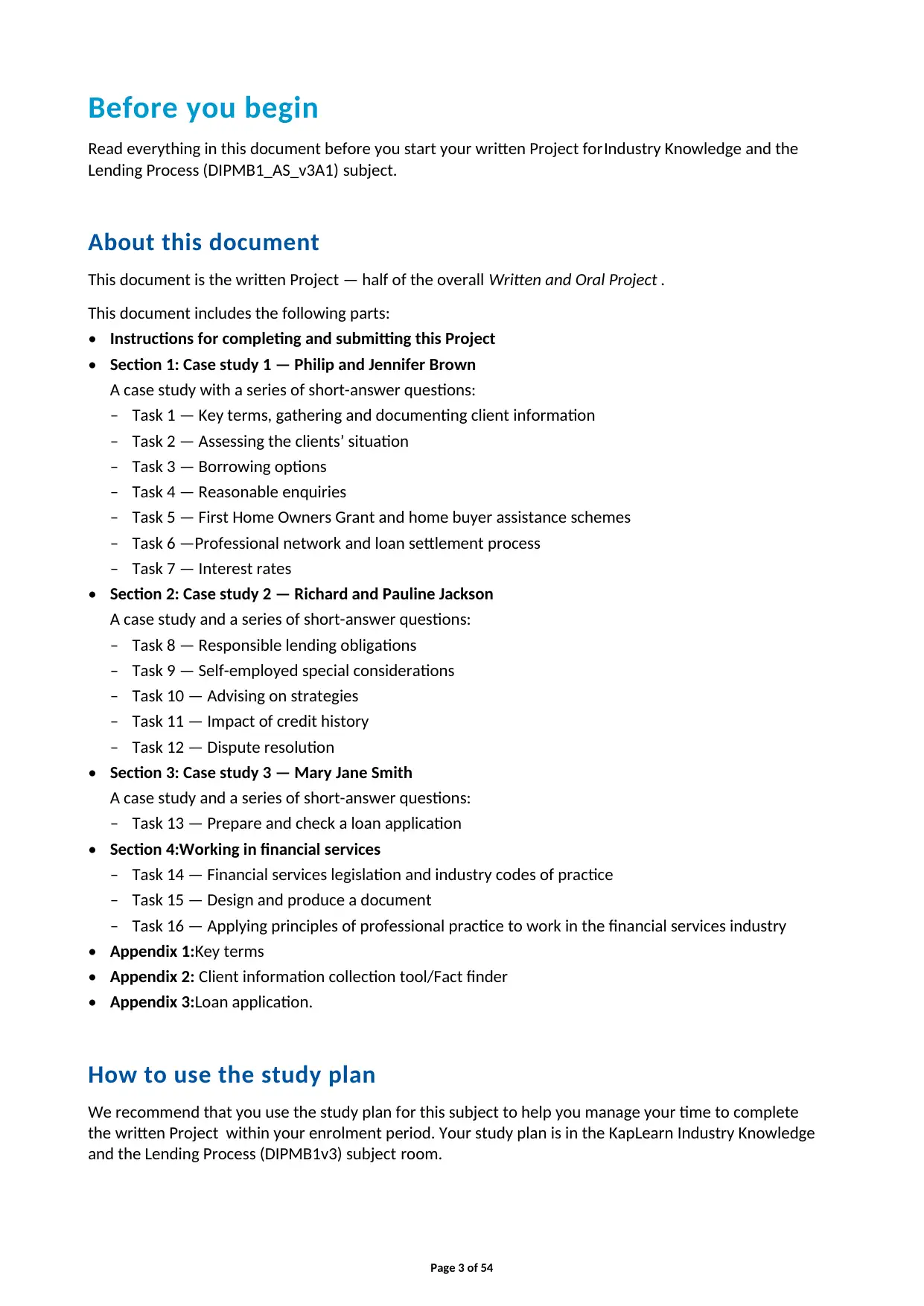
Before you begin
Read everything in this document before you start your written Project forIndustry Knowledge and the
Lending Process (DIPMB1_AS_v3A1) subject.
About this document
This document is the written Project — half of the overall Written and Oral Project .
This document includes the following parts:
• Instructions for completing and submitting this Project
• Section 1: Case study 1 — Philip and Jennifer Brown
A case study with a series of short-answer questions:
– Task 1 — Key terms, gathering and documenting client information
– Task 2 — Assessing the clients’ situation
– Task 3 — Borrowing options
– Task 4 — Reasonable enquiries
– Task 5 — First Home Owners Grant and home buyer assistance schemes
– Task 6 —Professional network and loan settlement process
– Task 7 — Interest rates
• Section 2: Case study 2 — Richard and Pauline Jackson
A case study and a series of short-answer questions:
– Task 8 — Responsible lending obligations
– Task 9 — Self-employed special considerations
– Task 10 — Advising on strategies
– Task 11 — Impact of credit history
– Task 12 — Dispute resolution
• Section 3: Case study 3 — Mary Jane Smith
A case study and a series of short-answer questions:
– Task 13 — Prepare and check a loan application
• Section 4:Working in financial services
– Task 14 — Financial services legislation and industry codes of practice
– Task 15 — Design and produce a document
– Task 16 — Applying principles of professional practice to work in the financial services industry
• Appendix 1:Key terms
• Appendix 2: Client information collection tool/Fact finder
• Appendix 3:Loan application.
How to use the study plan
We recommend that you use the study plan for this subject to help you manage your time to complete
the written Project within your enrolment period. Your study plan is in the KapLearn Industry Knowledge
and the Lending Process (DIPMB1v3) subject room.
Page 3 of 54
Read everything in this document before you start your written Project forIndustry Knowledge and the
Lending Process (DIPMB1_AS_v3A1) subject.
About this document
This document is the written Project — half of the overall Written and Oral Project .
This document includes the following parts:
• Instructions for completing and submitting this Project
• Section 1: Case study 1 — Philip and Jennifer Brown
A case study with a series of short-answer questions:
– Task 1 — Key terms, gathering and documenting client information
– Task 2 — Assessing the clients’ situation
– Task 3 — Borrowing options
– Task 4 — Reasonable enquiries
– Task 5 — First Home Owners Grant and home buyer assistance schemes
– Task 6 —Professional network and loan settlement process
– Task 7 — Interest rates
• Section 2: Case study 2 — Richard and Pauline Jackson
A case study and a series of short-answer questions:
– Task 8 — Responsible lending obligations
– Task 9 — Self-employed special considerations
– Task 10 — Advising on strategies
– Task 11 — Impact of credit history
– Task 12 — Dispute resolution
• Section 3: Case study 3 — Mary Jane Smith
A case study and a series of short-answer questions:
– Task 13 — Prepare and check a loan application
• Section 4:Working in financial services
– Task 14 — Financial services legislation and industry codes of practice
– Task 15 — Design and produce a document
– Task 16 — Applying principles of professional practice to work in the financial services industry
• Appendix 1:Key terms
• Appendix 2: Client information collection tool/Fact finder
• Appendix 3:Loan application.
How to use the study plan
We recommend that you use the study plan for this subject to help you manage your time to complete
the written Project within your enrolment period. Your study plan is in the KapLearn Industry Knowledge
and the Lending Process (DIPMB1v3) subject room.
Page 3 of 54
⊘ This is a preview!⊘
Do you want full access?
Subscribe today to unlock all pages.

Trusted by 1+ million students worldwide
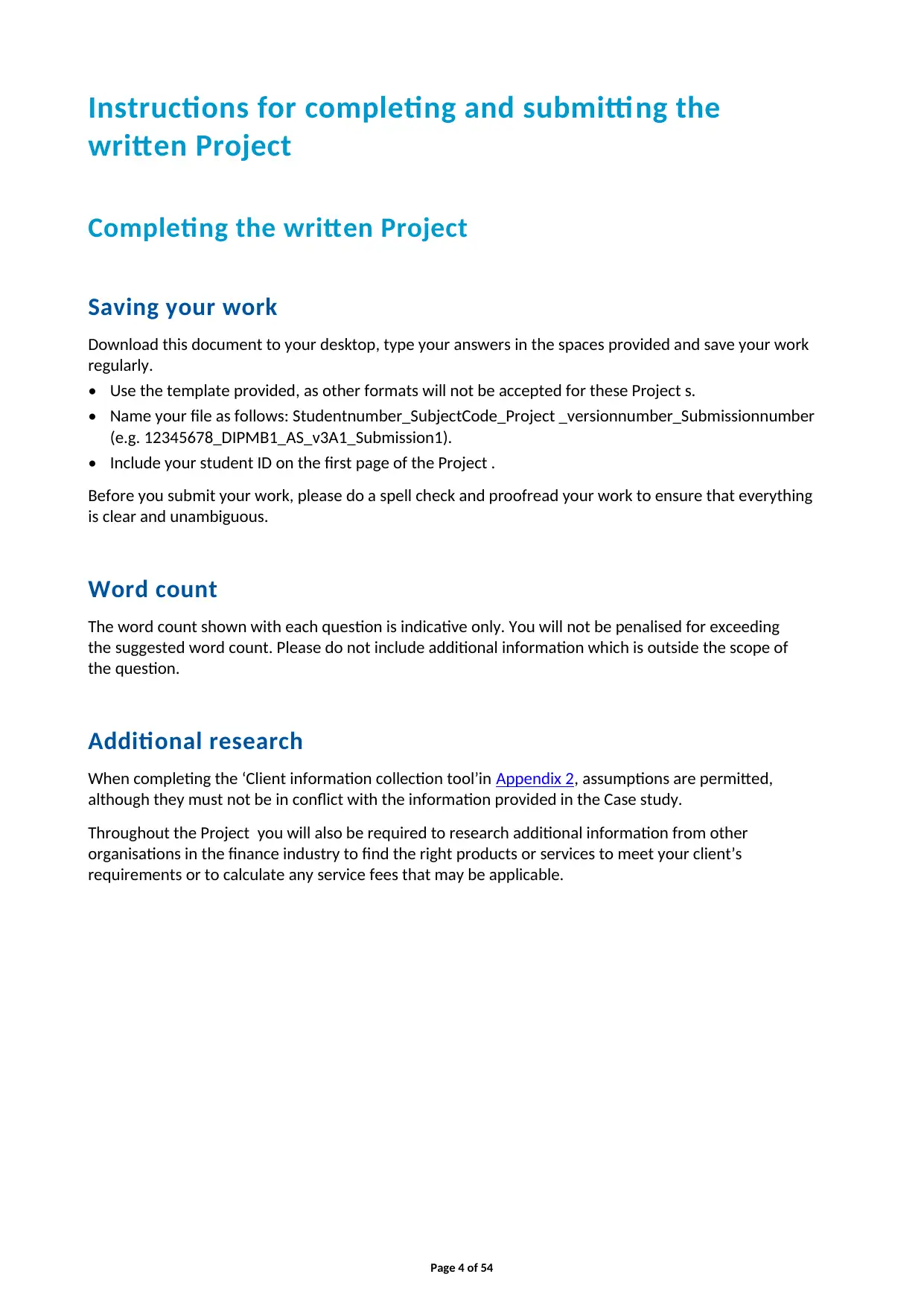
Instructions for completing and submitting the
written Project
Completing the written Project
Saving your work
Download this document to your desktop, type your answers in the spaces provided and save your work
regularly.
• Use the template provided, as other formats will not be accepted for these Project s.
• Name your file as follows: Studentnumber_SubjectCode_Project _versionnumber_Submissionnumber
(e.g. 12345678_DIPMB1_AS_v3A1_Submission1).
• Include your student ID on the first page of the Project .
Before you submit your work, please do a spell check and proofread your work to ensure that everything
is clear and unambiguous.
Word count
The word count shown with each question is indicative only. You will not be penalised for exceeding
the suggested word count. Please do not include additional information which is outside the scope of
the question.
Additional research
When completing the ‘Client information collection tool’in Appendix 2, assumptions are permitted,
although they must not be in conflict with the information provided in the Case study.
Throughout the Project you will also be required to research additional information from other
organisations in the finance industry to find the right products or services to meet your client’s
requirements or to calculate any service fees that may be applicable.
Page 4 of 54
written Project
Completing the written Project
Saving your work
Download this document to your desktop, type your answers in the spaces provided and save your work
regularly.
• Use the template provided, as other formats will not be accepted for these Project s.
• Name your file as follows: Studentnumber_SubjectCode_Project _versionnumber_Submissionnumber
(e.g. 12345678_DIPMB1_AS_v3A1_Submission1).
• Include your student ID on the first page of the Project .
Before you submit your work, please do a spell check and proofread your work to ensure that everything
is clear and unambiguous.
Word count
The word count shown with each question is indicative only. You will not be penalised for exceeding
the suggested word count. Please do not include additional information which is outside the scope of
the question.
Additional research
When completing the ‘Client information collection tool’in Appendix 2, assumptions are permitted,
although they must not be in conflict with the information provided in the Case study.
Throughout the Project you will also be required to research additional information from other
organisations in the finance industry to find the right products or services to meet your client’s
requirements or to calculate any service fees that may be applicable.
Page 4 of 54
Paraphrase This Document
Need a fresh take? Get an instant paraphrase of this document with our AI Paraphraser
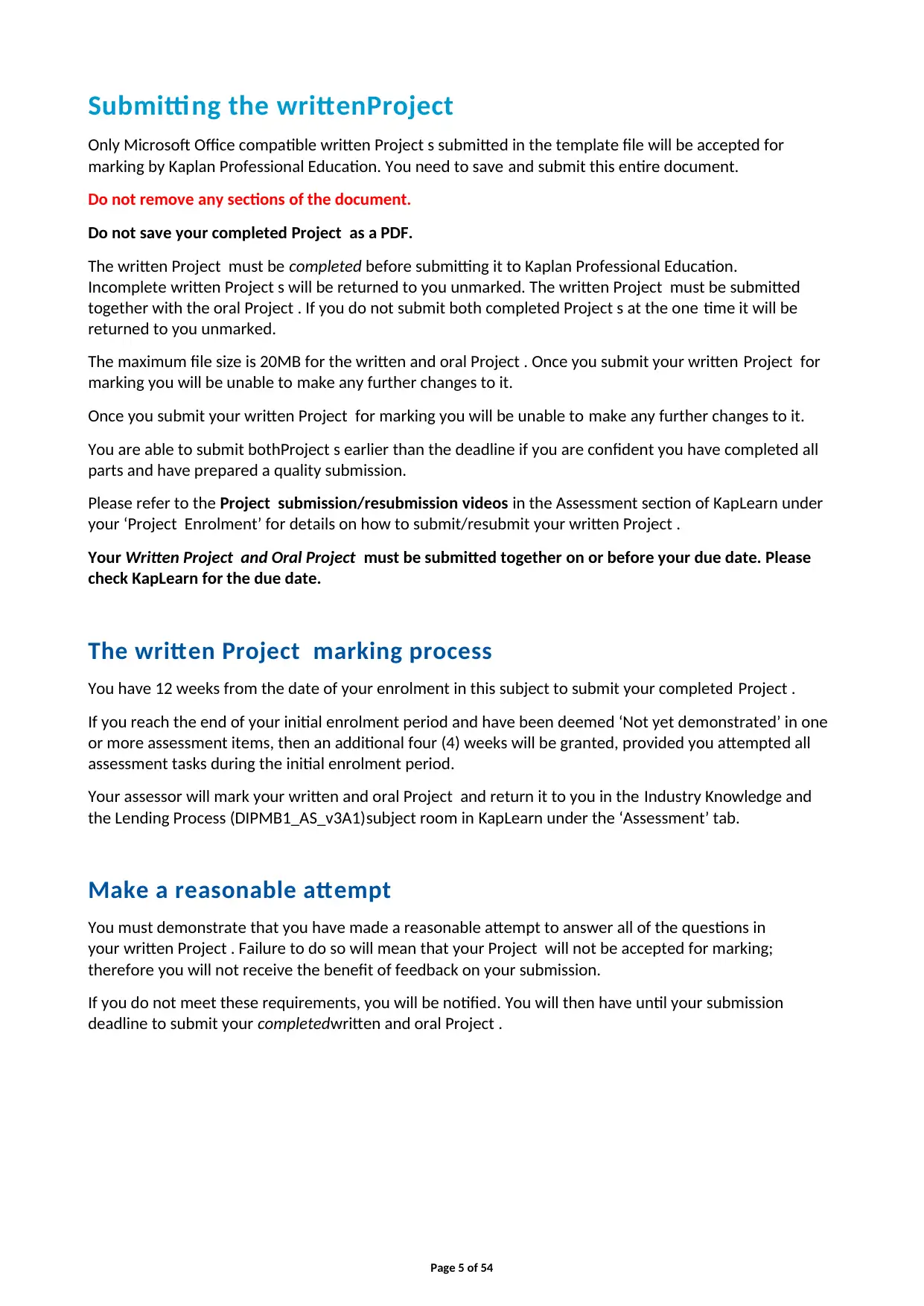
Submitting the writtenProject
Only Microsoft Office compatible written Project s submitted in the template file will be accepted for
marking by Kaplan Professional Education. You need to save and submit this entire document.
Do not remove any sections of the document.
Do not save your completed Project as a PDF.
The written Project must be completed before submitting it to Kaplan Professional Education.
Incomplete written Project s will be returned to you unmarked. The written Project must be submitted
together with the oral Project . If you do not submit both completed Project s at the one time it will be
returned to you unmarked.
The maximum file size is 20MB for the written and oral Project . Once you submit your written Project for
marking you will be unable to make any further changes to it.
Once you submit your written Project for marking you will be unable to make any further changes to it.
You are able to submit bothProject s earlier than the deadline if you are confident you have completed all
parts and have prepared a quality submission.
Please refer to the Project submission/resubmission videos in the Assessment section of KapLearn under
your ‘Project Enrolment’ for details on how to submit/resubmit your written Project .
Your Written Project and Oral Project must be submitted together on or before your due date. Please
check KapLearn for the due date.
The written Project marking process
You have 12 weeks from the date of your enrolment in this subject to submit your completed Project .
If you reach the end of your initial enrolment period and have been deemed ‘Not yet demonstrated’ in one
or more assessment items, then an additional four (4) weeks will be granted, provided you attempted all
assessment tasks during the initial enrolment period.
Your assessor will mark your written and oral Project and return it to you in the Industry Knowledge and
the Lending Process (DIPMB1_AS_v3A1)subject room in KapLearn under the ‘Assessment’ tab.
Make a reasonable attempt
You must demonstrate that you have made a reasonable attempt to answer all of the questions in
your written Project . Failure to do so will mean that your Project will not be accepted for marking;
therefore you will not receive the benefit of feedback on your submission.
If you do not meet these requirements, you will be notified. You will then have until your submission
deadline to submit your completedwritten and oral Project .
Page 5 of 54
Only Microsoft Office compatible written Project s submitted in the template file will be accepted for
marking by Kaplan Professional Education. You need to save and submit this entire document.
Do not remove any sections of the document.
Do not save your completed Project as a PDF.
The written Project must be completed before submitting it to Kaplan Professional Education.
Incomplete written Project s will be returned to you unmarked. The written Project must be submitted
together with the oral Project . If you do not submit both completed Project s at the one time it will be
returned to you unmarked.
The maximum file size is 20MB for the written and oral Project . Once you submit your written Project for
marking you will be unable to make any further changes to it.
Once you submit your written Project for marking you will be unable to make any further changes to it.
You are able to submit bothProject s earlier than the deadline if you are confident you have completed all
parts and have prepared a quality submission.
Please refer to the Project submission/resubmission videos in the Assessment section of KapLearn under
your ‘Project Enrolment’ for details on how to submit/resubmit your written Project .
Your Written Project and Oral Project must be submitted together on or before your due date. Please
check KapLearn for the due date.
The written Project marking process
You have 12 weeks from the date of your enrolment in this subject to submit your completed Project .
If you reach the end of your initial enrolment period and have been deemed ‘Not yet demonstrated’ in one
or more assessment items, then an additional four (4) weeks will be granted, provided you attempted all
assessment tasks during the initial enrolment period.
Your assessor will mark your written and oral Project and return it to you in the Industry Knowledge and
the Lending Process (DIPMB1_AS_v3A1)subject room in KapLearn under the ‘Assessment’ tab.
Make a reasonable attempt
You must demonstrate that you have made a reasonable attempt to answer all of the questions in
your written Project . Failure to do so will mean that your Project will not be accepted for marking;
therefore you will not receive the benefit of feedback on your submission.
If you do not meet these requirements, you will be notified. You will then have until your submission
deadline to submit your completedwritten and oral Project .
Page 5 of 54
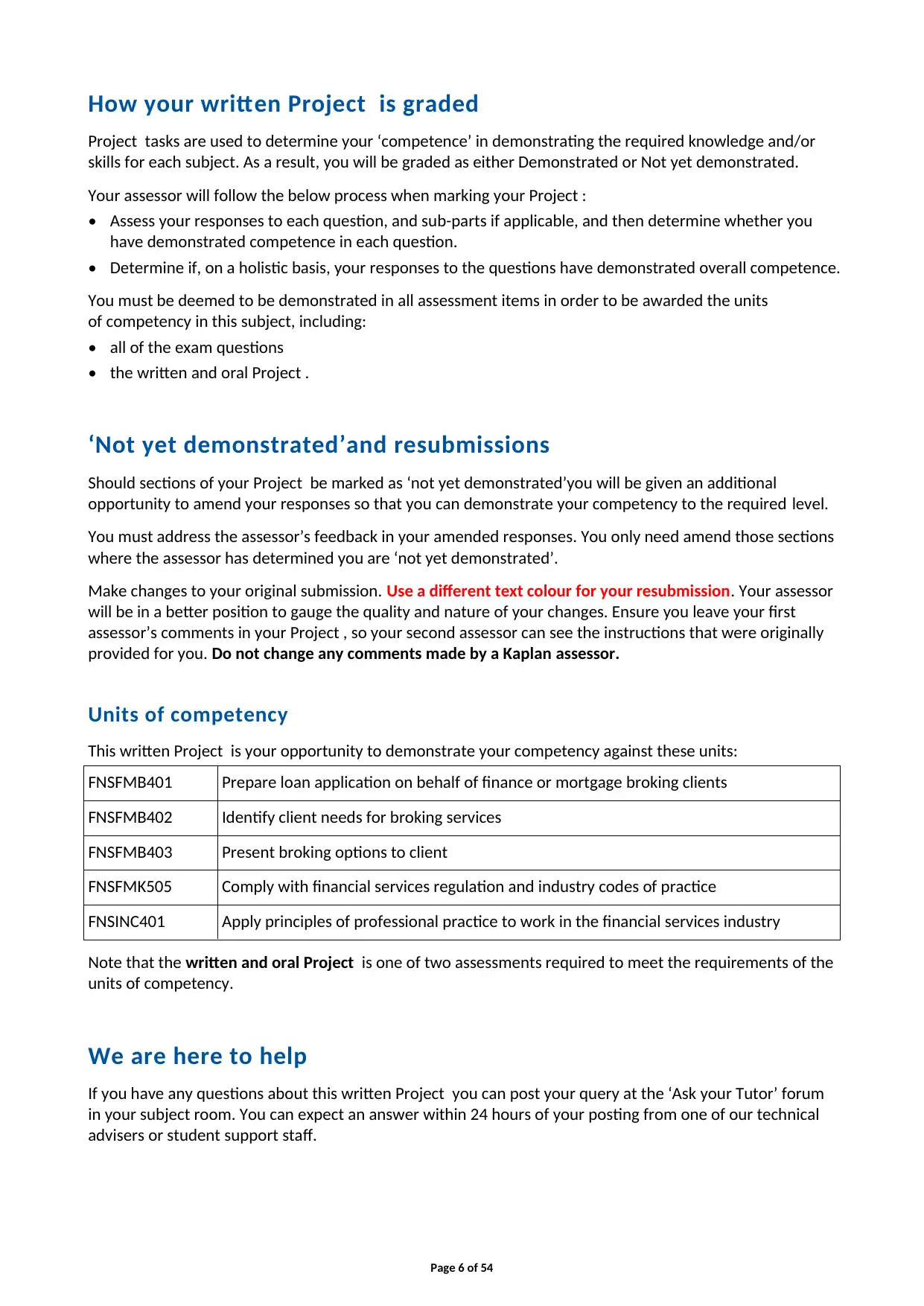
How your written Project is graded
Project tasks are used to determine your ‘competence’ in demonstrating the required knowledge and/or
skills for each subject. As a result, you will be graded as either Demonstrated or Not yet demonstrated.
Your assessor will follow the below process when marking your Project :
• Assess your responses to each question, and sub-parts if applicable, and then determine whether you
have demonstrated competence in each question.
• Determine if, on a holistic basis, your responses to the questions have demonstrated overall competence.
You must be deemed to be demonstrated in all assessment items in order to be awarded the units
of competency in this subject, including:
• all of the exam questions
• the written and oral Project .
‘Not yet demonstrated’and resubmissions
Should sections of your Project be marked as ‘not yet demonstrated’you will be given an additional
opportunity to amend your responses so that you can demonstrate your competency to the required level.
You must address the assessor’s feedback in your amended responses. You only need amend those sections
where the assessor has determined you are ‘not yet demonstrated’.
Make changes to your original submission. Use a different text colour for your resubmission. Your assessor
will be in a better position to gauge the quality and nature of your changes. Ensure you leave your first
assessor’s comments in your Project , so your second assessor can see the instructions that were originally
provided for you. Do not change any comments made by a Kaplan assessor.
Units of competency
This written Project is your opportunity to demonstrate your competency against these units:
FNSFMB401 Prepare loan application on behalf of finance or mortgage broking clients
FNSFMB402 Identify client needs for broking services
FNSFMB403 Present broking options to client
FNSFMK505 Comply with financial services regulation and industry codes of practice
FNSINC401 Apply principles of professional practice to work in the financial services industry
Note that the written and oral Project is one of two assessments required to meet the requirements of the
units of competency.
We are here to help
If you have any questions about this written Project you can post your query at the ‘Ask your Tutor’ forum
in your subject room. You can expect an answer within 24 hours of your posting from one of our technical
advisers or student support staff.
Page 6 of 54
Project tasks are used to determine your ‘competence’ in demonstrating the required knowledge and/or
skills for each subject. As a result, you will be graded as either Demonstrated or Not yet demonstrated.
Your assessor will follow the below process when marking your Project :
• Assess your responses to each question, and sub-parts if applicable, and then determine whether you
have demonstrated competence in each question.
• Determine if, on a holistic basis, your responses to the questions have demonstrated overall competence.
You must be deemed to be demonstrated in all assessment items in order to be awarded the units
of competency in this subject, including:
• all of the exam questions
• the written and oral Project .
‘Not yet demonstrated’and resubmissions
Should sections of your Project be marked as ‘not yet demonstrated’you will be given an additional
opportunity to amend your responses so that you can demonstrate your competency to the required level.
You must address the assessor’s feedback in your amended responses. You only need amend those sections
where the assessor has determined you are ‘not yet demonstrated’.
Make changes to your original submission. Use a different text colour for your resubmission. Your assessor
will be in a better position to gauge the quality and nature of your changes. Ensure you leave your first
assessor’s comments in your Project , so your second assessor can see the instructions that were originally
provided for you. Do not change any comments made by a Kaplan assessor.
Units of competency
This written Project is your opportunity to demonstrate your competency against these units:
FNSFMB401 Prepare loan application on behalf of finance or mortgage broking clients
FNSFMB402 Identify client needs for broking services
FNSFMB403 Present broking options to client
FNSFMK505 Comply with financial services regulation and industry codes of practice
FNSINC401 Apply principles of professional practice to work in the financial services industry
Note that the written and oral Project is one of two assessments required to meet the requirements of the
units of competency.
We are here to help
If you have any questions about this written Project you can post your query at the ‘Ask your Tutor’ forum
in your subject room. You can expect an answer within 24 hours of your posting from one of our technical
advisers or student support staff.
Page 6 of 54
⊘ This is a preview!⊘
Do you want full access?
Subscribe today to unlock all pages.

Trusted by 1+ million students worldwide
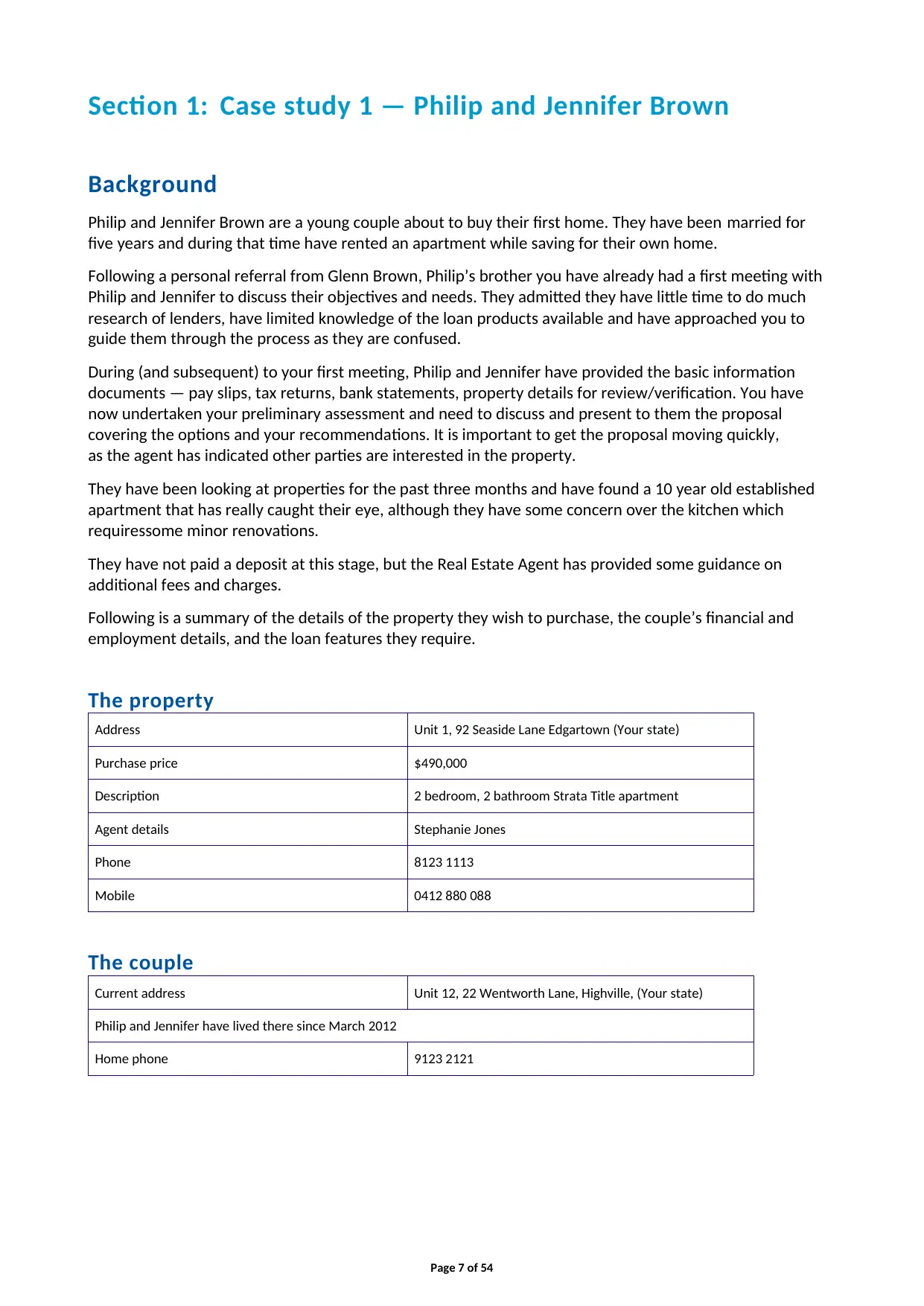
Section 1: Case study 1 — Philip and Jennifer Brown
Background
Philip and Jennifer Brown are a young couple about to buy their first home. They have been married for
five years and during that time have rented an apartment while saving for their own home.
Following a personal referral from Glenn Brown, Philip’s brother you have already had a first meeting with
Philip and Jennifer to discuss their objectives and needs. They admitted they have little time to do much
research of lenders, have limited knowledge of the loan products available and have approached you to
guide them through the process as they are confused.
During (and subsequent) to your first meeting, Philip and Jennifer have provided the basic information
documents — pay slips, tax returns, bank statements, property details for review/verification. You have
now undertaken your preliminary assessment and need to discuss and present to them the proposal
covering the options and your recommendations. It is important to get the proposal moving quickly,
as the agent has indicated other parties are interested in the property.
They have been looking at properties for the past three months and have found a 10 year old established
apartment that has really caught their eye, although they have some concern over the kitchen which
requiressome minor renovations.
They have not paid a deposit at this stage, but the Real Estate Agent has provided some guidance on
additional fees and charges.
Following is a summary of the details of the property they wish to purchase, the couple’s financial and
employment details, and the loan features they require.
The property
Address Unit 1, 92 Seaside Lane Edgartown (Your state)
Purchase price $490,000
Description 2 bedroom, 2 bathroom Strata Title apartment
Agent details Stephanie Jones
Phone 8123 1113
Mobile 0412 880 088
The couple
Current address Unit 12, 22 Wentworth Lane, Highville, (Your state)
Philip and Jennifer have lived there since March 2012
Home phone 9123 2121
Page 7 of 54
Background
Philip and Jennifer Brown are a young couple about to buy their first home. They have been married for
five years and during that time have rented an apartment while saving for their own home.
Following a personal referral from Glenn Brown, Philip’s brother you have already had a first meeting with
Philip and Jennifer to discuss their objectives and needs. They admitted they have little time to do much
research of lenders, have limited knowledge of the loan products available and have approached you to
guide them through the process as they are confused.
During (and subsequent) to your first meeting, Philip and Jennifer have provided the basic information
documents — pay slips, tax returns, bank statements, property details for review/verification. You have
now undertaken your preliminary assessment and need to discuss and present to them the proposal
covering the options and your recommendations. It is important to get the proposal moving quickly,
as the agent has indicated other parties are interested in the property.
They have been looking at properties for the past three months and have found a 10 year old established
apartment that has really caught their eye, although they have some concern over the kitchen which
requiressome minor renovations.
They have not paid a deposit at this stage, but the Real Estate Agent has provided some guidance on
additional fees and charges.
Following is a summary of the details of the property they wish to purchase, the couple’s financial and
employment details, and the loan features they require.
The property
Address Unit 1, 92 Seaside Lane Edgartown (Your state)
Purchase price $490,000
Description 2 bedroom, 2 bathroom Strata Title apartment
Agent details Stephanie Jones
Phone 8123 1113
Mobile 0412 880 088
The couple
Current address Unit 12, 22 Wentworth Lane, Highville, (Your state)
Philip and Jennifer have lived there since March 2012
Home phone 9123 2121
Page 7 of 54
Paraphrase This Document
Need a fresh take? Get an instant paraphrase of this document with our AI Paraphraser
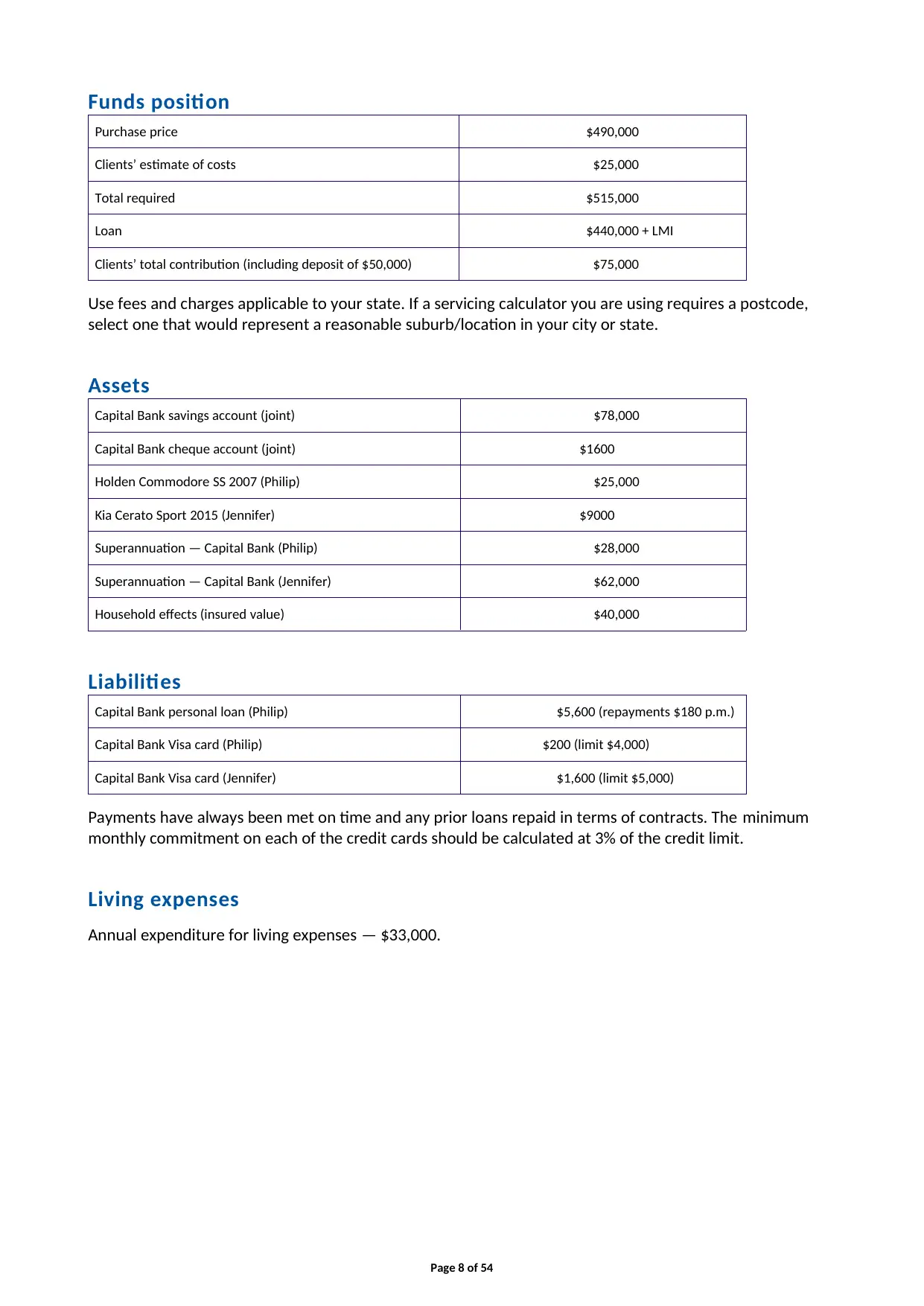
Funds position
Purchase price $490,000
Clients’ estimate of costs $25,000
Total required $515,000
Loan $440,000 + LMI
Clients’ total contribution (including deposit of $50,000) $75,000
Use fees and charges applicable to your state. If a servicing calculator you are using requires a postcode,
select one that would represent a reasonable suburb/location in your city or state.
Assets
Capital Bank savings account (joint) $78,000
Capital Bank cheque account (joint) $1600
Holden Commodore SS 2007 (Philip) $25,000
Kia Cerato Sport 2015 (Jennifer) $9000
Superannuation — Capital Bank (Philip) $28,000
Superannuation — Capital Bank (Jennifer) $62,000
Household effects (insured value) $40,000
Liabilities
Capital Bank personal loan (Philip) $5,600 (repayments $180 p.m.)
Capital Bank Visa card (Philip) $200 (limit $4,000)
Capital Bank Visa card (Jennifer) $1,600 (limit $5,000)
Payments have always been met on time and any prior loans repaid in terms of contracts. The minimum
monthly commitment on each of the credit cards should be calculated at 3% of the credit limit.
Living expenses
Annual expenditure for living expenses — $33,000.
Page 8 of 54
Purchase price $490,000
Clients’ estimate of costs $25,000
Total required $515,000
Loan $440,000 + LMI
Clients’ total contribution (including deposit of $50,000) $75,000
Use fees and charges applicable to your state. If a servicing calculator you are using requires a postcode,
select one that would represent a reasonable suburb/location in your city or state.
Assets
Capital Bank savings account (joint) $78,000
Capital Bank cheque account (joint) $1600
Holden Commodore SS 2007 (Philip) $25,000
Kia Cerato Sport 2015 (Jennifer) $9000
Superannuation — Capital Bank (Philip) $28,000
Superannuation — Capital Bank (Jennifer) $62,000
Household effects (insured value) $40,000
Liabilities
Capital Bank personal loan (Philip) $5,600 (repayments $180 p.m.)
Capital Bank Visa card (Philip) $200 (limit $4,000)
Capital Bank Visa card (Jennifer) $1,600 (limit $5,000)
Payments have always been met on time and any prior loans repaid in terms of contracts. The minimum
monthly commitment on each of the credit cards should be calculated at 3% of the credit limit.
Living expenses
Annual expenditure for living expenses — $33,000.
Page 8 of 54
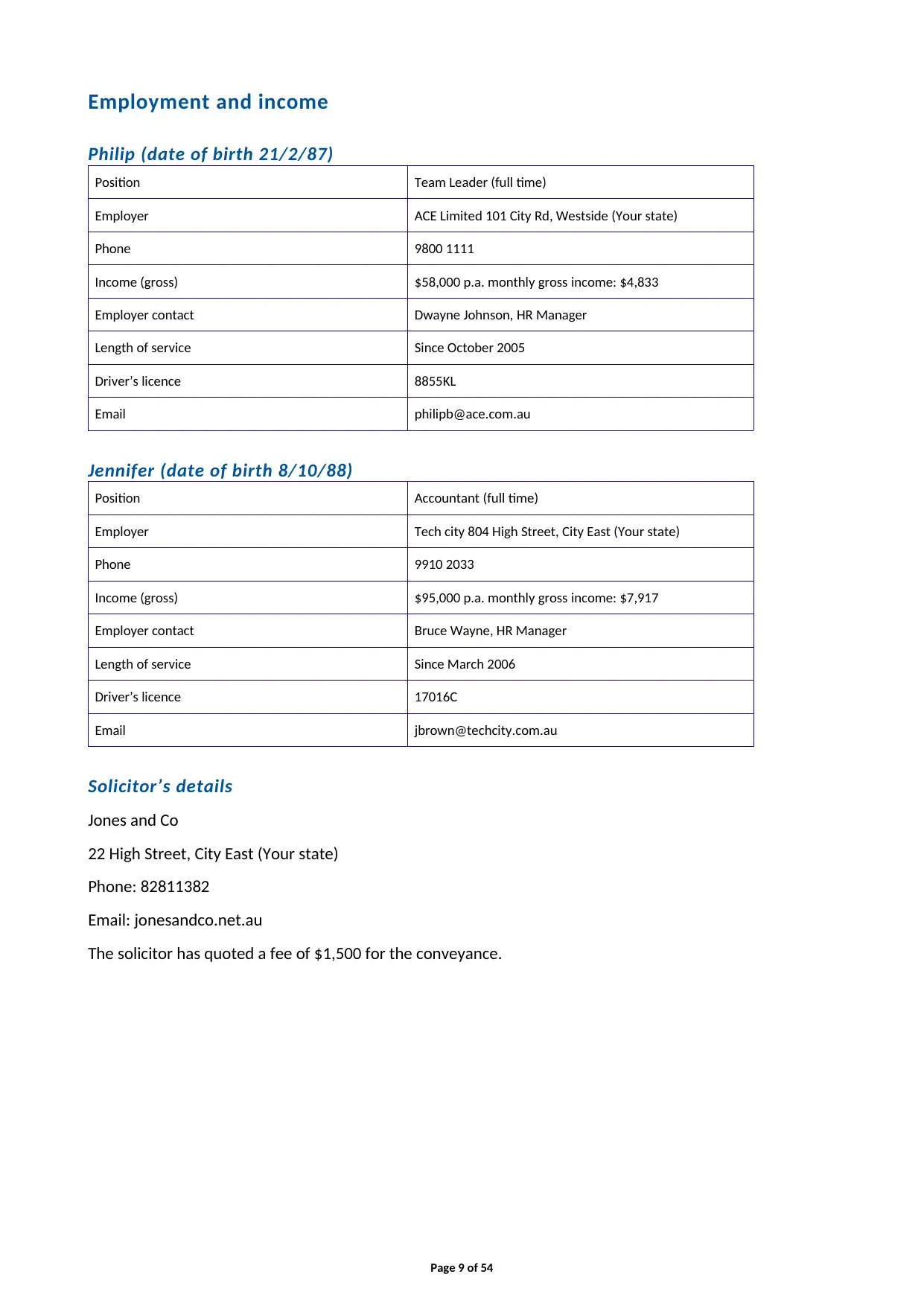
Employment and income
Philip (date of birth 21/2/87)
Position Team Leader (full time)
Employer ACE Limited 101 City Rd, Westside (Your state)
Phone 9800 1111
Income (gross) $58,000 p.a. monthly gross income: $4,833
Employer contact Dwayne Johnson, HR Manager
Length of service Since October 2005
Driver’s licence 8855KL
Email philipb@ace.com.au
Jennifer (date of birth 8/10/88)
Position Accountant (full time)
Employer Tech city 804 High Street, City East (Your state)
Phone 9910 2033
Income (gross) $95,000 p.a. monthly gross income: $7,917
Employer contact Bruce Wayne, HR Manager
Length of service Since March 2006
Driver’s licence 17016C
Email jbrown@techcity.com.au
Solicitor’s details
Jones and Co
22 High Street, City East (Your state)
Phone: 82811382
Email: jonesandco.net.au
The solicitor has quoted a fee of $1,500 for the conveyance.
Page 9 of 54
Philip (date of birth 21/2/87)
Position Team Leader (full time)
Employer ACE Limited 101 City Rd, Westside (Your state)
Phone 9800 1111
Income (gross) $58,000 p.a. monthly gross income: $4,833
Employer contact Dwayne Johnson, HR Manager
Length of service Since October 2005
Driver’s licence 8855KL
Email philipb@ace.com.au
Jennifer (date of birth 8/10/88)
Position Accountant (full time)
Employer Tech city 804 High Street, City East (Your state)
Phone 9910 2033
Income (gross) $95,000 p.a. monthly gross income: $7,917
Employer contact Bruce Wayne, HR Manager
Length of service Since March 2006
Driver’s licence 17016C
Email jbrown@techcity.com.au
Solicitor’s details
Jones and Co
22 High Street, City East (Your state)
Phone: 82811382
Email: jonesandco.net.au
The solicitor has quoted a fee of $1,500 for the conveyance.
Page 9 of 54
⊘ This is a preview!⊘
Do you want full access?
Subscribe today to unlock all pages.

Trusted by 1+ million students worldwide
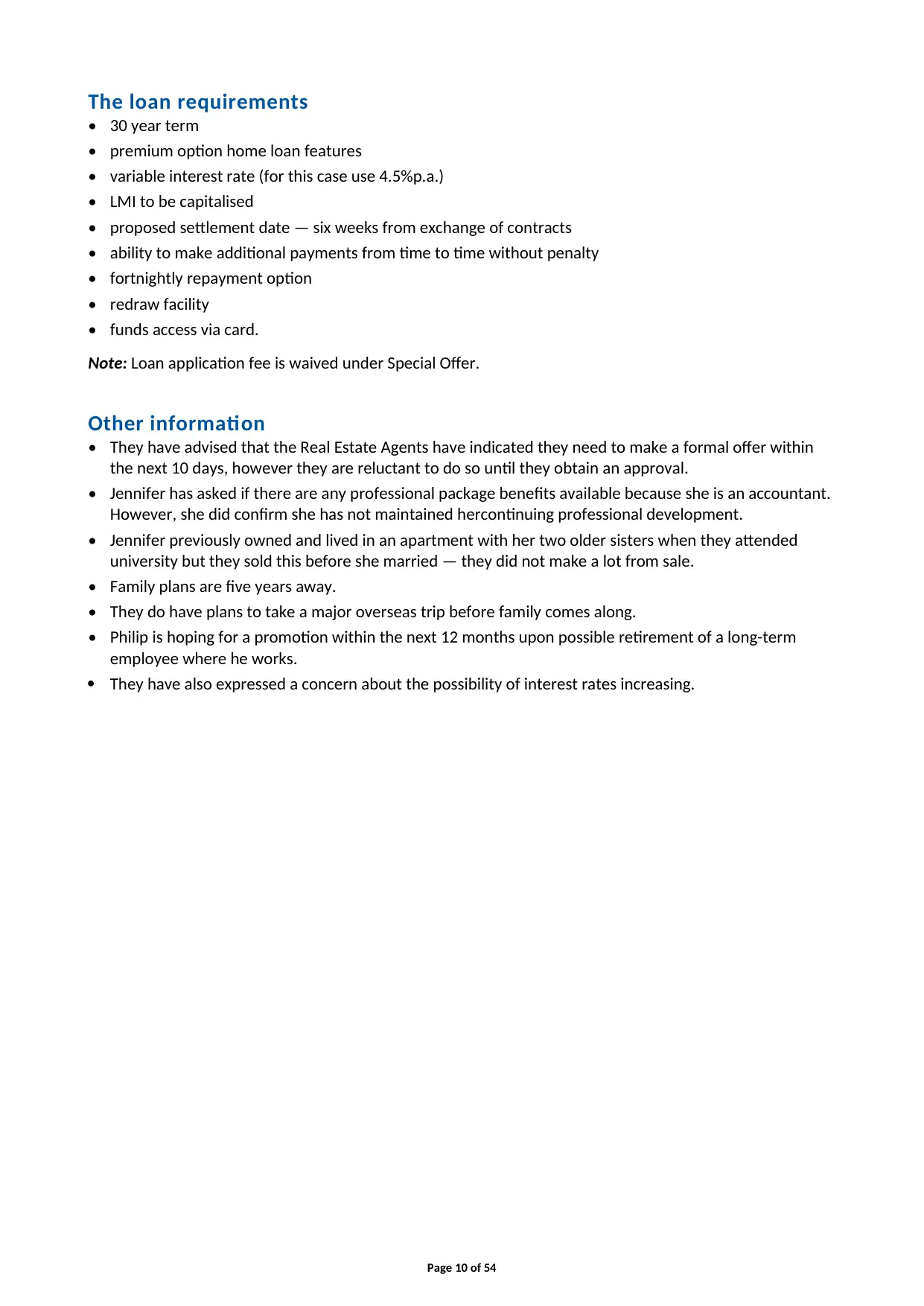
The loan requirements
• 30 year term
• premium option home loan features
• variable interest rate (for this case use 4.5%p.a.)
• LMI to be capitalised
• proposed settlement date — six weeks from exchange of contracts
• ability to make additional payments from time to time without penalty
• fortnightly repayment option
• redraw facility
• funds access via card.
Note: Loan application fee is waived under Special Offer.
Other information
• They have advised that the Real Estate Agents have indicated they need to make a formal offer within
the next 10 days, however they are reluctant to do so until they obtain an approval.
• Jennifer has asked if there are any professional package benefits available because she is an accountant.
However, she did confirm she has not maintained hercontinuing professional development.
• Jennifer previously owned and lived in an apartment with her two older sisters when they attended
university but they sold this before she married — they did not make a lot from sale.
• Family plans are five years away.
• They do have plans to take a major overseas trip before family comes along.
• Philip is hoping for a promotion within the next 12 months upon possible retirement of a long-term
employee where he works.
They have also expressed a concern about the possibility of interest rates increasing.
Page 10 of 54
• 30 year term
• premium option home loan features
• variable interest rate (for this case use 4.5%p.a.)
• LMI to be capitalised
• proposed settlement date — six weeks from exchange of contracts
• ability to make additional payments from time to time without penalty
• fortnightly repayment option
• redraw facility
• funds access via card.
Note: Loan application fee is waived under Special Offer.
Other information
• They have advised that the Real Estate Agents have indicated they need to make a formal offer within
the next 10 days, however they are reluctant to do so until they obtain an approval.
• Jennifer has asked if there are any professional package benefits available because she is an accountant.
However, she did confirm she has not maintained hercontinuing professional development.
• Jennifer previously owned and lived in an apartment with her two older sisters when they attended
university but they sold this before she married — they did not make a lot from sale.
• Family plans are five years away.
• They do have plans to take a major overseas trip before family comes along.
• Philip is hoping for a promotion within the next 12 months upon possible retirement of a long-term
employee where he works.
They have also expressed a concern about the possibility of interest rates increasing.
Page 10 of 54
Paraphrase This Document
Need a fresh take? Get an instant paraphrase of this document with our AI Paraphraser
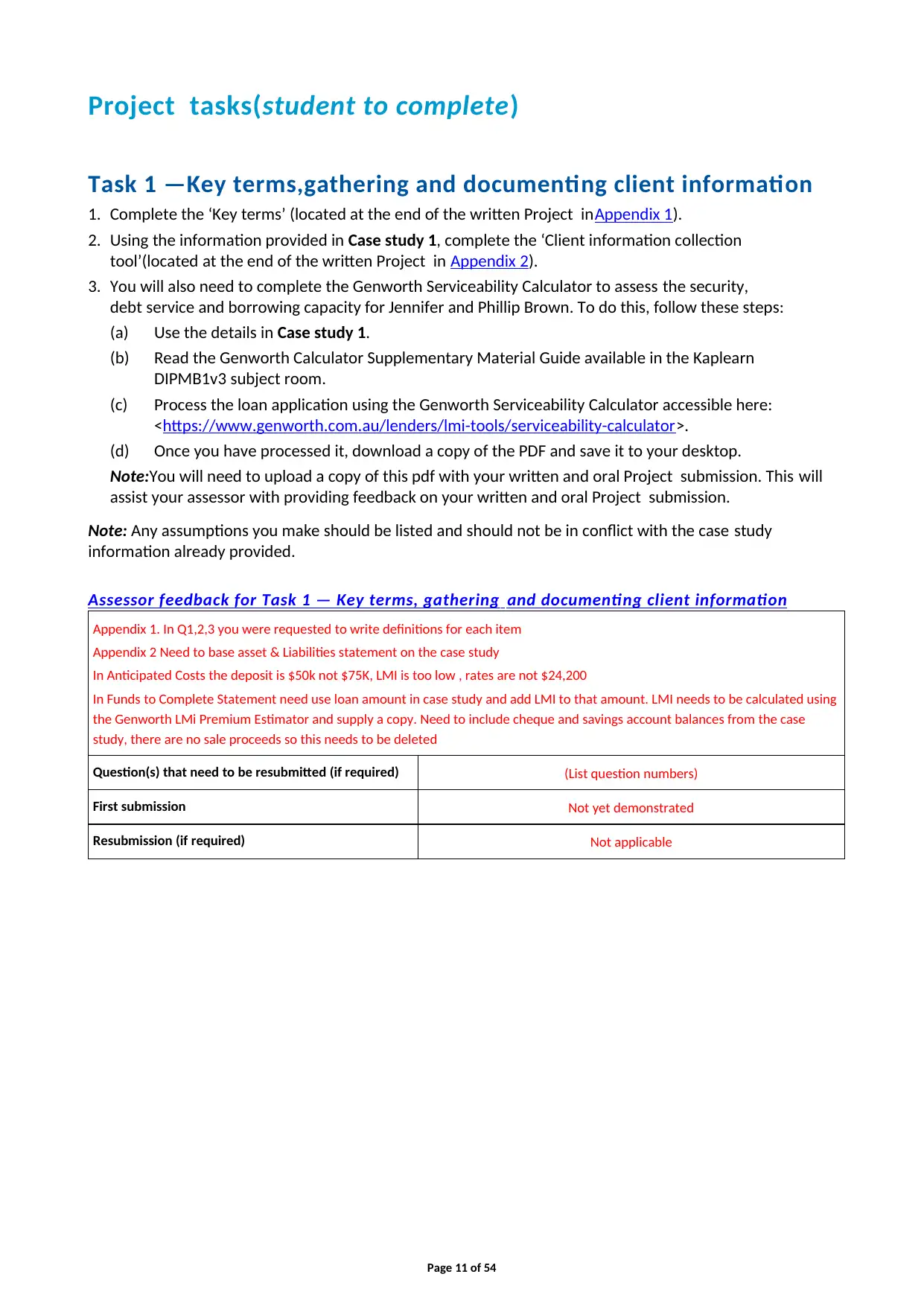
Project tasks(student to complete)
Task 1 —Key terms,gathering and documenting client information
1. Complete the ‘Key terms’ (located at the end of the written Project inAppendix 1).
2. Using the information provided in Case study 1, complete the ‘Client information collection
tool’(located at the end of the written Project in Appendix 2).
3. You will also need to complete the Genworth Serviceability Calculator to assess the security,
debt service and borrowing capacity for Jennifer and Phillip Brown. To do this, follow these steps:
(a) Use the details in Case study 1.
(b) Read the Genworth Calculator Supplementary Material Guide available in the Kaplearn
DIPMB1v3 subject room.
(c) Process the loan application using the Genworth Serviceability Calculator accessible here:
<https://www.genworth.com.au/lenders/lmi-tools/serviceability-calculator>.
(d) Once you have processed it, download a copy of the PDF and save it to your desktop.
Note:You will need to upload a copy of this pdf with your written and oral Project submission. This will
assist your assessor with providing feedback on your written and oral Project submission.
Note: Any assumptions you make should be listed and should not be in conflict with the case study
information already provided.
Assessor feedback for Task 1 — Key terms, gathering and documenting client information
Appendix 1. In Q1,2,3 you were requested to write definitions for each item
Appendix 2 Need to base asset & Liabilities statement on the case study
In Anticipated Costs the deposit is $50k not $75K, LMI is too low , rates are not $24,200
In Funds to Complete Statement need use loan amount in case study and add LMI to that amount. LMI needs to be calculated using
the Genworth LMi Premium Estimator and supply a copy. Need to include cheque and savings account balances from the case
study, there are no sale proceeds so this needs to be deleted
Question(s) that need to be resubmitted (if required) (List question numbers)
First submission Not yet demonstrated
Resubmission (if required) Not applicable
Page 11 of 54
Task 1 —Key terms,gathering and documenting client information
1. Complete the ‘Key terms’ (located at the end of the written Project inAppendix 1).
2. Using the information provided in Case study 1, complete the ‘Client information collection
tool’(located at the end of the written Project in Appendix 2).
3. You will also need to complete the Genworth Serviceability Calculator to assess the security,
debt service and borrowing capacity for Jennifer and Phillip Brown. To do this, follow these steps:
(a) Use the details in Case study 1.
(b) Read the Genworth Calculator Supplementary Material Guide available in the Kaplearn
DIPMB1v3 subject room.
(c) Process the loan application using the Genworth Serviceability Calculator accessible here:
<https://www.genworth.com.au/lenders/lmi-tools/serviceability-calculator>.
(d) Once you have processed it, download a copy of the PDF and save it to your desktop.
Note:You will need to upload a copy of this pdf with your written and oral Project submission. This will
assist your assessor with providing feedback on your written and oral Project submission.
Note: Any assumptions you make should be listed and should not be in conflict with the case study
information already provided.
Assessor feedback for Task 1 — Key terms, gathering and documenting client information
Appendix 1. In Q1,2,3 you were requested to write definitions for each item
Appendix 2 Need to base asset & Liabilities statement on the case study
In Anticipated Costs the deposit is $50k not $75K, LMI is too low , rates are not $24,200
In Funds to Complete Statement need use loan amount in case study and add LMI to that amount. LMI needs to be calculated using
the Genworth LMi Premium Estimator and supply a copy. Need to include cheque and savings account balances from the case
study, there are no sale proceeds so this needs to be deleted
Question(s) that need to be resubmitted (if required) (List question numbers)
First submission Not yet demonstrated
Resubmission (if required) Not applicable
Page 11 of 54
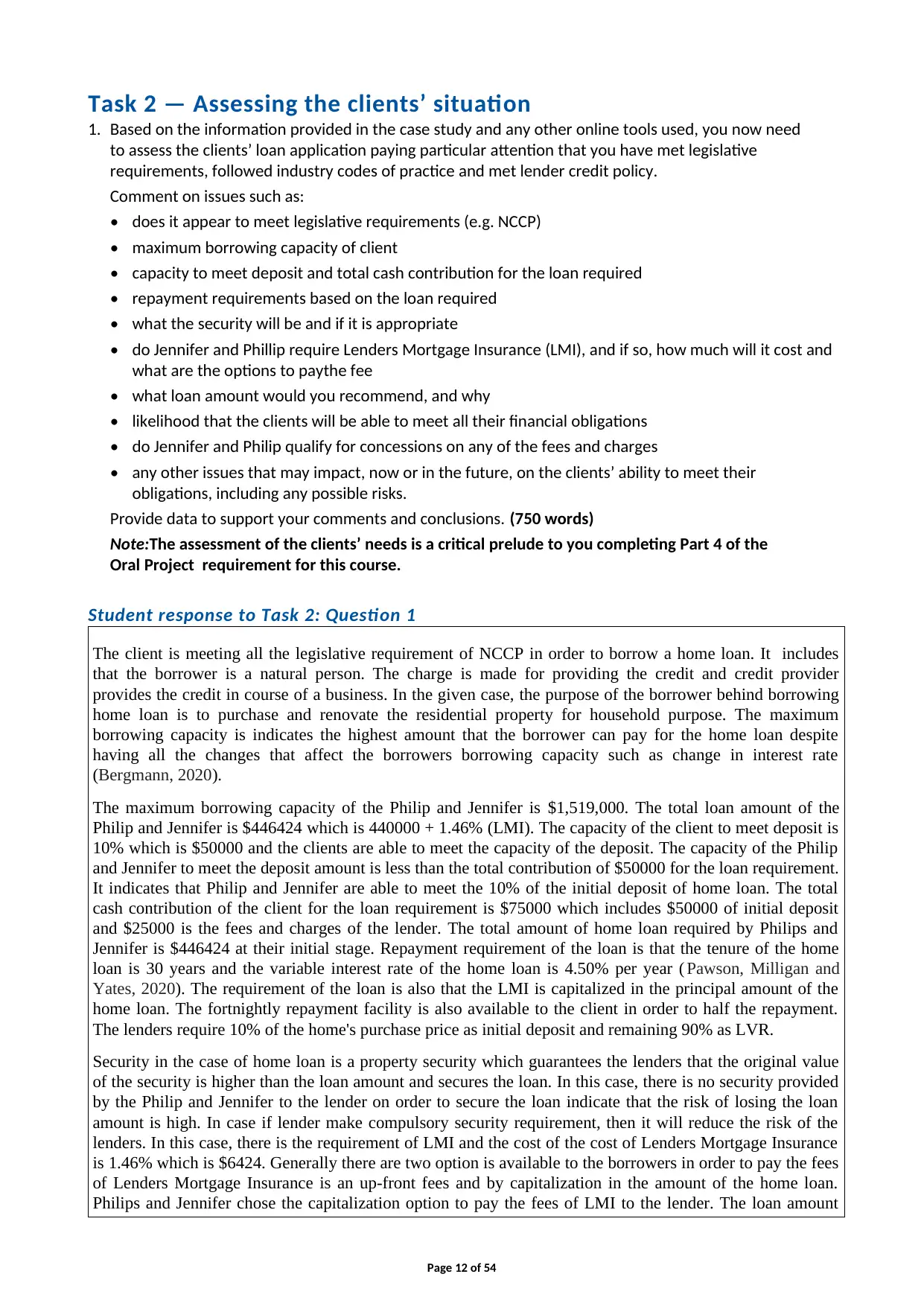
Task 2 — Assessing the clients’ situation
1. Based on the information provided in the case study and any other online tools used, you now need
to assess the clients’ loan application paying particular attention that you have met legislative
requirements, followed industry codes of practice and met lender credit policy.
Comment on issues such as:
• does it appear to meet legislative requirements (e.g. NCCP)
• maximum borrowing capacity of client
• capacity to meet deposit and total cash contribution for the loan required
• repayment requirements based on the loan required
• what the security will be and if it is appropriate
• do Jennifer and Phillip require Lenders Mortgage Insurance (LMI), and if so, how much will it cost and
what are the options to paythe fee
• what loan amount would you recommend, and why
• likelihood that the clients will be able to meet all their financial obligations
• do Jennifer and Philip qualify for concessions on any of the fees and charges
• any other issues that may impact, now or in the future, on the clients’ ability to meet their
obligations, including any possible risks.
Provide data to support your comments and conclusions. (750 words)
Note:The assessment of the clients’ needs is a critical prelude to you completing Part 4 of the
Oral Project requirement for this course.
Student response to Task 2: Question 1
The client is meeting all the legislative requirement of NCCP in order to borrow a home loan. It includes
that the borrower is a natural person. The charge is made for providing the credit and credit provider
provides the credit in course of a business. In the given case, the purpose of the borrower behind borrowing
home loan is to purchase and renovate the residential property for household purpose. The maximum
borrowing capacity is indicates the highest amount that the borrower can pay for the home loan despite
having all the changes that affect the borrowers borrowing capacity such as change in interest rate
(Bergmann, 2020).
The maximum borrowing capacity of the Philip and Jennifer is $1,519,000. The total loan amount of the
Philip and Jennifer is $446424 which is 440000 + 1.46% (LMI). The capacity of the client to meet deposit is
10% which is $50000 and the clients are able to meet the capacity of the deposit. The capacity of the Philip
and Jennifer to meet the deposit amount is less than the total contribution of $50000 for the loan requirement.
It indicates that Philip and Jennifer are able to meet the 10% of the initial deposit of home loan. The total
cash contribution of the client for the loan requirement is $75000 which includes $50000 of initial deposit
and $25000 is the fees and charges of the lender. The total amount of home loan required by Philips and
Jennifer is $446424 at their initial stage. Repayment requirement of the loan is that the tenure of the home
loan is 30 years and the variable interest rate of the home loan is 4.50% per year ( Pawson, Milligan and
Yates, 2020). The requirement of the loan is also that the LMI is capitalized in the principal amount of the
home loan. The fortnightly repayment facility is also available to the client in order to half the repayment.
The lenders require 10% of the home's purchase price as initial deposit and remaining 90% as LVR.
Security in the case of home loan is a property security which guarantees the lenders that the original value
of the security is higher than the loan amount and secures the loan. In this case, there is no security provided
by the Philip and Jennifer to the lender on order to secure the loan indicate that the risk of losing the loan
amount is high. In case if lender make compulsory security requirement, then it will reduce the risk of the
lenders. In this case, there is the requirement of LMI and the cost of the cost of Lenders Mortgage Insurance
is 1.46% which is $6424. Generally there are two option is available to the borrowers in order to pay the fees
of Lenders Mortgage Insurance is an up-front fees and by capitalization in the amount of the home loan.
Philips and Jennifer chose the capitalization option to pay the fees of LMI to the lender. The loan amount
Page 12 of 54
1. Based on the information provided in the case study and any other online tools used, you now need
to assess the clients’ loan application paying particular attention that you have met legislative
requirements, followed industry codes of practice and met lender credit policy.
Comment on issues such as:
• does it appear to meet legislative requirements (e.g. NCCP)
• maximum borrowing capacity of client
• capacity to meet deposit and total cash contribution for the loan required
• repayment requirements based on the loan required
• what the security will be and if it is appropriate
• do Jennifer and Phillip require Lenders Mortgage Insurance (LMI), and if so, how much will it cost and
what are the options to paythe fee
• what loan amount would you recommend, and why
• likelihood that the clients will be able to meet all their financial obligations
• do Jennifer and Philip qualify for concessions on any of the fees and charges
• any other issues that may impact, now or in the future, on the clients’ ability to meet their
obligations, including any possible risks.
Provide data to support your comments and conclusions. (750 words)
Note:The assessment of the clients’ needs is a critical prelude to you completing Part 4 of the
Oral Project requirement for this course.
Student response to Task 2: Question 1
The client is meeting all the legislative requirement of NCCP in order to borrow a home loan. It includes
that the borrower is a natural person. The charge is made for providing the credit and credit provider
provides the credit in course of a business. In the given case, the purpose of the borrower behind borrowing
home loan is to purchase and renovate the residential property for household purpose. The maximum
borrowing capacity is indicates the highest amount that the borrower can pay for the home loan despite
having all the changes that affect the borrowers borrowing capacity such as change in interest rate
(Bergmann, 2020).
The maximum borrowing capacity of the Philip and Jennifer is $1,519,000. The total loan amount of the
Philip and Jennifer is $446424 which is 440000 + 1.46% (LMI). The capacity of the client to meet deposit is
10% which is $50000 and the clients are able to meet the capacity of the deposit. The capacity of the Philip
and Jennifer to meet the deposit amount is less than the total contribution of $50000 for the loan requirement.
It indicates that Philip and Jennifer are able to meet the 10% of the initial deposit of home loan. The total
cash contribution of the client for the loan requirement is $75000 which includes $50000 of initial deposit
and $25000 is the fees and charges of the lender. The total amount of home loan required by Philips and
Jennifer is $446424 at their initial stage. Repayment requirement of the loan is that the tenure of the home
loan is 30 years and the variable interest rate of the home loan is 4.50% per year ( Pawson, Milligan and
Yates, 2020). The requirement of the loan is also that the LMI is capitalized in the principal amount of the
home loan. The fortnightly repayment facility is also available to the client in order to half the repayment.
The lenders require 10% of the home's purchase price as initial deposit and remaining 90% as LVR.
Security in the case of home loan is a property security which guarantees the lenders that the original value
of the security is higher than the loan amount and secures the loan. In this case, there is no security provided
by the Philip and Jennifer to the lender on order to secure the loan indicate that the risk of losing the loan
amount is high. In case if lender make compulsory security requirement, then it will reduce the risk of the
lenders. In this case, there is the requirement of LMI and the cost of the cost of Lenders Mortgage Insurance
is 1.46% which is $6424. Generally there are two option is available to the borrowers in order to pay the fees
of Lenders Mortgage Insurance is an up-front fees and by capitalization in the amount of the home loan.
Philips and Jennifer chose the capitalization option to pay the fees of LMI to the lender. The loan amount
Page 12 of 54
⊘ This is a preview!⊘
Do you want full access?
Subscribe today to unlock all pages.

Trusted by 1+ million students worldwide
1 out of 51
Related Documents
Your All-in-One AI-Powered Toolkit for Academic Success.
+13062052269
info@desklib.com
Available 24*7 on WhatsApp / Email
![[object Object]](/_next/static/media/star-bottom.7253800d.svg)
Unlock your academic potential
Copyright © 2020–2025 A2Z Services. All Rights Reserved. Developed and managed by ZUCOL.





